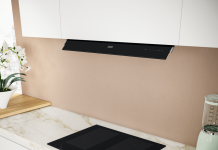The engineer and researcher Elisabetta Comini describes the ambit of her studies and the consequences that may derive, for the household appliance world as well, with the firm belief that the collaboration among physics, material science, engineering, biology and computer science can improve the wellbeing for mind and body.
“Nanotechnology and nanosciences are attracting rising investments and interest worldwide. They are essential to succeed in increasing our knowledge of the matter and of the phenomena occurring on nanometric scale, promising new applications and development of industrial prototypes and an eventual marketing. For this reason, the control in the production of innovative materials and nanostructures is fundamental to create new revolutionary technologies and platforms in various areas of interest, like domotics, smart buildings, biomedicine, environmental safety, control of food quality, of water resources and of life, in a broader sense”. From these remarks develops the job of Elisabetta Comini, associate professor of the Department of Information Engineering of Brescia Faculty, specialized in material physics and protagonist of researches in various ambits and multidisciplinary scientific activities. Thanks to her curriculum, the researcher has been included in the project “100 Women against stereotypes”, an online databank cared by the Pavia Observatory, institute of communication analysis and research, and by the association Gi.U.Li.A, net of Autonomous United Free Journalists, joined by 100 professionals and including curricula of expert women in the ambit of Science, Technology, Engineering and Mathematics (STEM), sectors scarcely represented by women historically and at the same time strategic for the economic and social development of the Country.
What is your mission, in detail, Elisabetta Comini?
My researches are aimed at extending knowledge in the material science. I work at the study, preparation and characterization of materials, especially of metal oxides and their integration into devices. This class of materials features the most disparate physical and chemical properties, we find isolating oxides, semiconductors and even nearly-metals, superconductors, and therefore they can be exploited for the preparation of devices of various kind. The main characteristic and the advantage of working with oxides is linked with the thermal stability, which assures stability and then potential reliability of the devices that exploit the active properties of these materials.
Thanks to the intrinsic properties of these materials and also to the possibility of modifying their shape, obtaining some nanostructures, it is possible to prepare some devices such as for instance sensors of chemical or gaseous species.

What applications can stem from the results of your researches?
Sensors have and will have an ever-increasing impact on the aspects of our life: in particular, chemical sensors are the necessary interface to acquire chemical information in the environment that surrounds us in real time.
This set of information can provide a control system of our life quality but also a system to check any type of chemical process: detection of toxic and explosive analytes, safety systems to protect workers against chemical risks, the monitoring of the external environment, the control of the food chain, and the monitoring of health and wellbeing.
The advantage of the use of nanotechnologies consists in the better performances of these chemical sensors, since they can solve or decrease some of the problems that until now have hindered the marketing of conventional devices, they can be more sensitive and besides they can be introduced in whatever position and used in sensor nets to monitor the chemical information according to the position and the time. This allows providing a distribution, a map of noxious and toxic chemical substances in real time. Inserted for instance in portable phones, they can warn us to avoid a zone where there are some noxious chemical species or the pollution is too high at that time.
The quality of the atmospheric air or of the air inside buildings can be monitored and related to chronic diseases, for instance, and this can provide information about the enhancement of health and wellbeing. The importance of relying on a mapping, an objective datum consists precisely in the possible correlation with people’s health and wellbeing, this gives us the possibility of intervening!!
In Italy, the concepts of spirit, mind, body and wellbeing accompany everybody’s daily life and have a great significance. Over the years, this concept has gained more and more value and, currently, it does not refer only to the absence of illnesses but instead to a general wellbeing where body and mind are considered as a whole. Therefore, it is essential to have some instruments to measure objectively the parameters that can be connected with the state of total comfort.
Do you think that a connection can exist between your research and the household appliance world?
Yes, absolutely, this type of chemical sensors, for instance, can provide information about the presence of volatile species to be correlated with the goodness of a food, to make an example a sensor inserted into a refrigerator might inform us that the fresh fish we bought and stored in the fridge some days before must be consumed or is no longer edible. Another opportunity is the use of sensors for the detection of the volatile species that are released by foods while cooking in order to automate an electric oven.
Obviously, each case needs a specific study and design because the species to be detected change and it is necessary to associate the type of response with the particular situation. The sensor resembles a baby, we must teach it what is the odour of the good fish and of baked bread, so that it can distinguish them once it has grown and help us in our everyday life: to switch the oven off before the dish burns or to avoid poisoning caused by battered foods.
What is your opinion about the future of this sector?
Chemical sensors are essential instruments to create new lifestyles that are consistent with a sustainable society. To enhance the progress in this sector further, it is important to integrate the various aspects that characterize it and that range from physics, chemistry and science of materials to engineering, biology, computer science and much more. Precisely this interdisciplinarity that characterizes it slows down the progress because the research must be carried out by work teams with different and disparate backgrounds.
In the study of the sensor detection system, fundamental importance is held by the functional properties of the active material and by all that surrounds it, allows exploiting its properties and transmitting them to users as a number, a signal. Moreover, it is important, but still difficult, not to stop at lab tests, sometimes too far from real tests. In the research, we should lavish the greatest effort to implement tests as close as possible to the reality, to the real work environment of these devices. For this reason, are increasingly important the studies to confirm the feasibility and to demonstrate clearly the potentialities of chemical sensors and the synergistic combination of functional and fundamental characterizations, using studies that are called in ‘operando’ conditions.
All these possible innovations can really produce a significant improvement of our lifestyle. Maybe nanotechnology has been overestimated for its short-term expectations but concerning the long term there will be remarkable implications for healthcare, productivity and environment.
In my opinion, in particular, metal oxides remain the most promising class of sensitive materials for the development of chemical sensors, thanks to simple production methods and to the chemical stability. Metal oxides were the first marketed under the form of chemical sensors for conductivity and they will be part of the future of chemical sensors under various forms, such as the nanostructures at which I work. My contribution concerns just the preparation, the optimization of this type of materials, so that they can satisfy the requisites of these devices in terms of reliability, stability and sensitivity when they are integrated into the final device. The proof of the faith we have in this kind of research, together with other employees of Brescia University, was the creation, in slightly more than one month, of the innovative start up Nano Sensor Systems (Nasys) aimed at granting the possibility of exploiting from the practical point of view the know-how generated inside the university, making it available for the community.






